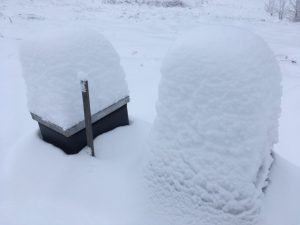
Is it a bad or poor queen? Ever fewer reliable producers of vetted and proven quality queens. Or is it winters that seem to be more fickle than normal. Warm and devious, followed by three foot February snowfalls that caught all by surprise, esp. the active hives.
Winters, drought, climate change and a jet stream run amok certainly play their role. Others single out mites, faulty or ineffective mite treatment. I would add no pollen or polluted pollen leading to bad bee bread.
Disease, skinny anorexic bees … the offspring of crappy queens. Hives not wrapped, not insulated, or too much insulation leading to Nosema. Lack of honey reserves or syrup saved to get them through the fall and winter. All are possibilities.
I also suggest that there often is a fall “pollen dearth. It is nice to have a hive filled up with bee bread and pollen reserves. One reason I am big on trying to provide more Winter pollen sources like the Garrya eliptica.
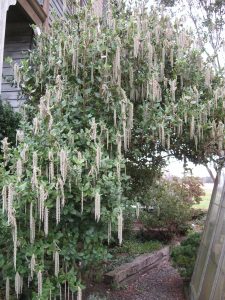
McComb property. Garrya eliptica male
Mites/virus are an issue but are manageable. The question to ask is are we really controlling mites and varroa better today. The Apiguard or Randy Oliver’s oxalic paper strips? I tried the later and it did not seem to work. Neither can I say the sugar dusting/with essential oils works if stopped in October. Which I did. Others swear by formic acid. Others say it is worthless. To discuss Oxalic acid applications please visit this helpful page. Randy Oliver probably has the most updates on different methods than anyone.
Heat vaporizers like the ones OxaVap sells are something your bee club should invest in … as well as considering finding someone to do everyone’s hives for a charge.
This years catastrophic losses stemmed when all my hives SAVE the Caucasian went on a looting rampage and hit an abandoned apiary down the road. They brought back a lot of varroa and died. Food was in the frames.
However, I also searched for the dead queen and found none. Mostly, the dead were young bees. AND no apparent varroa mite bodies or evidence in the body postmortems.
I am guessing other things may be a factor. Late fall spraying of shrubs and plants … fungicides and herbicides and other contaminants may in fact be stored in the needed pollen. This chemical overexposure becomes totally critical come spring with the egregious over-spraying of dandelions and lawn weeds in that precious lawn. Further, what exactly is in those purchased bee patties? If imported from China they could be totally contaminated. How do we buy from Amazon and get a guarantee about the quality, safety and origin of the stuff. Hell, even dog food is contaminated as are baby foods.
Throw in the risk the beekeeper (not me) takes by placing their hives in orchards to pollinate crops that may get sprayed. Your own efforts to plant winter-flowering perennials, shrubs, bulbs and climbers in your garden is crucial and I have put up my own list of plants for you to try on. Avoid the sterile pansies and other bedding plants that produce neither nectar or pollen. Have a look at the list linked here for pollinator-friendly plants which will make your winter-active pollinators happy.
All these factors are limitations to the success of an apiary, large or small and in my own experience their survive ability is getting ever tougher. Last seasons loss to my own predacious activity was bad enough, but I am guessing that fifty percent losses and higher to hives is going to be a norm in the years to come.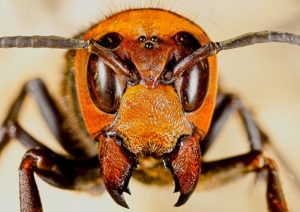
This totally excludes the newcomer Hornet threat. It is also getting harder and harder to find ‘safe’ locations for hives. Two years ago my neighbor across the street sprayed her lawn so heavily that my hedge of filberts died back to the ground. So did two of my hives. They were total colony collapse situations with five pounds of bees suddenly lying in front of the hive.
I finally threatened small claims court action against the hired gardeners and was damn certain to be out there with a camera taking pictures of their license plate and them in action. They have been much more careful ever since.
Throw in the nearby neighbor who in responding to a swarm call, holds MY own swarmed bees hostage for a quart of honey blackmail. Beekeeping is a game that has rudely evolved and has become a very expensive and sometimes confrontational occupation. One not protected by others or neighbors as valued at all. Nor is WA state helpful in dealing with diseased or junk yard apiaries.
As with plants, the idea of dumpster hoping for a new landscape is even more questionable when it comes to dead and damaged bee equipment. It is never a good idea to scavenge through what is diseased. The local property nearby has about ten hives that make the first picture look like a Mann Lake showroom. They need to be burned out or taken to the dump.
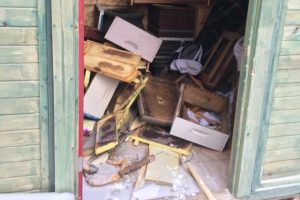 |
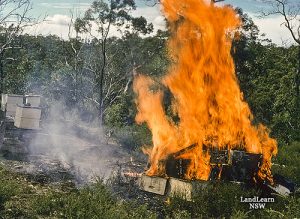 |
The general consensus is that hives that collapse late in the fall are the victims of mites. Either by an overload or a crash, meaning that they basically looked okay. Reality hits after the stress of the first freezes as flying conditions usually remain good enough that the weak infected hives will get robbed out OR that your own strong hives may contaminate their own by raiding the weak and sick. Mind you the feral and junk yard collapsed apiaries also add a seasonal visiting drone problem to your own. Or when kicked out of their own in the Fall they may find welcome in a weak and poorly guarded hive of your own.
That is another issue entirely. So is the leaving of extracted supers out to be cleaned by the greater neighborhood.
One thing that I did NOT check enough on was wing deformation, another varroa mite issue. This has two serious consequences. Without doubt it affects the flying ability of the bees to bring in the pollen and nectar. Equally serious, however such paralysis or deformity means they cannot vibrate their wings and bodies generously enough to keep the remaining brood cluster warm. Slowly the hive declines and even the queen fails. Is it through heartbreak?
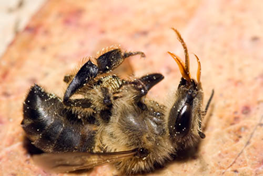
The curious thing about my losses was that there was NO evidence of Nosema, no stinking mass of dead bees and there was enough honey left in the hives… but there were NO pollen reserves at all. Protein is needed, esp. in cold weather and if the flying conditions deteriorate and or there is no pollen outside to gather, then the nurse bees die and the cluster continues to decline and freezes out.
Lack of honey, or the butt sticking out of the cell is an indicator of sugar or energy starvation obviously, but that may have occurred after the hive has been aggressively robbed.
Sugar cakes and providing some sort of protein patty on top of hive boxes in late November is a wise move. So is reducing the entrance and being on top of raiding behavior. It can happen at any time of the year, not just in the summer. BTW, I cannot stress enough the height reduction of the entrance to keep mice and voles out. Another problem in winter months.
What I return to however is my pollen suggestion. The pollen status of the hive in the fall is just as important as is the sugar feeding and if the frames do not have cells and frames filled with pollen, feed substitute and stay with one that works. Some Amazon offerings seem to be totally ignored by the bees and others are happily feasted upon. Please read my comment regarding the quality of these patties and a better alternative from Woods Bee Co. Another affordable supplier is Better Bees.
Not having found the dead queens in my dead hives suggests that I may simply have had failed queens and as some of them were from very late swarms that too is something to consider. “A swarm of bees in June Is worth a silver spoon; A swarm of bees in July Is not worth a fly.”
Not much to do about that. Queens will fail over winter too, more often today than when I had bees in California. Without replacement brood the hive is doomed and since replacement queens cannot be gotten till much later the hive will simply dwindle away and some bees will drift off to other stronger hives … and what is left will be robbed out.

Very interesting dilemma regarding bee patties. As expected buyer reviews on Amazon where all over the place. From ‘not touched’ to fermented and even cautions about freezing the stuff.
1.0 out of 5 stars
5.0 out of 5 stars
Others cautions involve the use of sucrose in the product. Most patties are selling in the 14.00 range.
Ultra Bee Pollen Patty: 1 pound sells for 3.75 from Woods Bee Co and has a much higher crude protein content. All ingredients are USA sourced and are made with Pro Health essential oils. https://woodsbeeco.com/product/pollen-patties/
Always research what you put into your hive.
The more I think about the $$$ involved in these losses I realize that investing in an – Oxalic Acid Vaporizer might be a wise investment.
That said, even an affordable one like Varrocleaner is expensive and when one adds a good acid respirator and protective gear it might be worth hiring someone to do it for you during that Oct. Nov. period.
Weather prevents one from opening up the hives for most other treatments so it is something to consider.
All I can say, is that derelict hives and abandoned cheap cardboard bait boxes are to be found everywhere and your bees will find them. Without some sort of treatment you will most likely lose them.